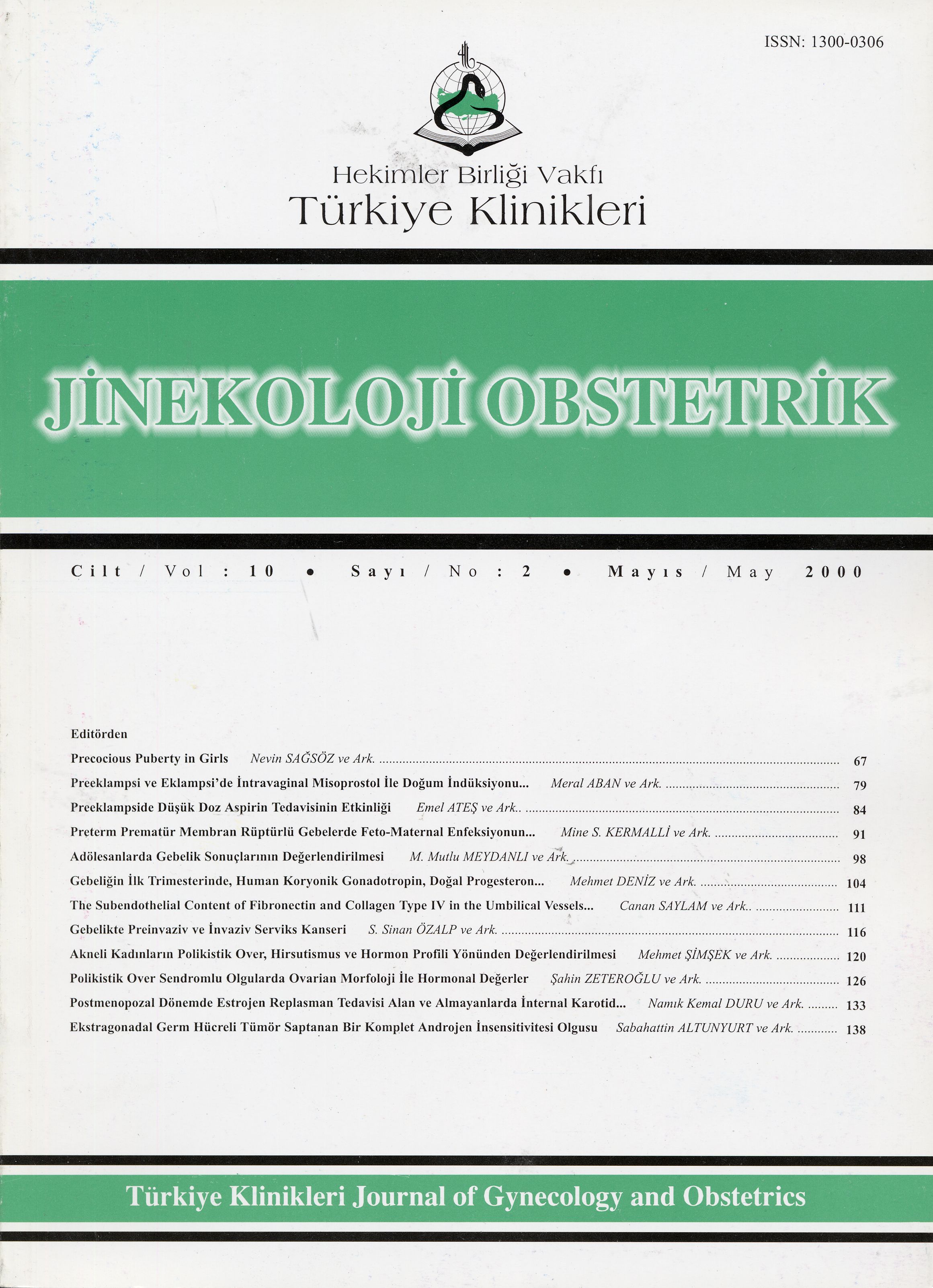Open Access
Peer Reviewed
ARTICLES
3613 Viewed1796 Downloaded
The Ovarian Morphology And Hormonal Values Of Polycystic Ovary Syndrome
Polikistik Over Sendromlu Olgularda Ovarian Morfoloji İle Hormonal Değerler
Turkiye Klinikleri J Gynecol Obst. 2000;10(2):126-32
Article Language: TR
Copyright Ⓒ 2025 by Türkiye Klinikleri. This is an open access article under the CC BY-NC-ND license (http://creativecommons.org/licenses/by-nc-nd/4.0/)
ÖZET
Amaç: Polikistik over sendromlu olgularda klinik, endokrinolojik, ultrasonografik bulgular ile Ferriman Gallway skorlarının herhangi bir jinekolojik yakınması olmayan kontrol grubu ile karşılaştırılması amaçlandı. Materyel ve Metod: Kasım 97 - Eylül 98 tarihleri arasında Kadın Hastalıkları ve Doğum polikliniğine başvuran klinik ve/veya endokrinolojik olarak Polikistik Over Sendromu ön tanısı konulan ve ultrasonografide polikistik over saptanan 112 hasta çalışma grubu olarak, herhangi bir obstetrik veya jinekolojik yakınması olmayan 91 hasta kontrol grubu olarak seçildi. Tüm hastalardan erken folliküler dönemde Follikül stimulan hormon, Luteinizan hormon, estradiol, Prolaktin, Dehidroepiandrosteron sülfat, Testesteron ve seks hormon bin-ding globulin çalışıldı. Hastalara erken folliküler dönemde ultrasonografi yapılarak over hacmi, alanı, çevresi ve kist sayıları değerlendirildi. Tüm inceleme ve ölçümler aynı uygulayıcı tarafından Toshiba SSA 270A Ultrasonografi cihazı ile gerçekleştirildi. Bulgular: Polikistik over sendromlu grupta Follikül stimulan hormon, Luteinizan hormon, Luteinizan hormon/Folikül stimülan hormon oranı, estradiol, prolaktin, testesteron ve dehidroepiandrosteron sülfat kontrol grubuna göre daha yüksek olarak saptanırken Seks hormon binding globulin daha düşük bulundu. Ferriman Gallway skor ortalamasının Polikistik over sendromu grubunda 17.13±0.86, kontrol grubunda 2.98±0.19 olduğu görüldü. Sonuç: Polikistik over Sendromu tanısı klinik ve endokrinolojik karekteristiklerinin heterojen olması nedeniyle üzerinde çok tartışılan bir konudur. Tanı kriterleri üzerinde bir konsensus olmamasına rağmen klinik ile beraber büyümüş overlerde polikistik görünüm, lüteinizan hormon/follikül stimulan hormon oranının artması halen geçerli kriterler olarak gözükmektedir.
Amaç: Polikistik over sendromlu olgularda klinik, endokrinolojik, ultrasonografik bulgular ile Ferriman Gallway skorlarının herhangi bir jinekolojik yakınması olmayan kontrol grubu ile karşılaştırılması amaçlandı. Materyel ve Metod: Kasım 97 - Eylül 98 tarihleri arasında Kadın Hastalıkları ve Doğum polikliniğine başvuran klinik ve/veya endokrinolojik olarak Polikistik Over Sendromu ön tanısı konulan ve ultrasonografide polikistik over saptanan 112 hasta çalışma grubu olarak, herhangi bir obstetrik veya jinekolojik yakınması olmayan 91 hasta kontrol grubu olarak seçildi. Tüm hastalardan erken folliküler dönemde Follikül stimulan hormon, Luteinizan hormon, estradiol, Prolaktin, Dehidroepiandrosteron sülfat, Testesteron ve seks hormon bin-ding globulin çalışıldı. Hastalara erken folliküler dönemde ultrasonografi yapılarak over hacmi, alanı, çevresi ve kist sayıları değerlendirildi. Tüm inceleme ve ölçümler aynı uygulayıcı tarafından Toshiba SSA 270A Ultrasonografi cihazı ile gerçekleştirildi. Bulgular: Polikistik over sendromlu grupta Follikül stimulan hormon, Luteinizan hormon, Luteinizan hormon/Folikül stimülan hormon oranı, estradiol, prolaktin, testesteron ve dehidroepiandrosteron sülfat kontrol grubuna göre daha yüksek olarak saptanırken Seks hormon binding globulin daha düşük bulundu. Ferriman Gallway skor ortalamasının Polikistik over sendromu grubunda 17.13±0.86, kontrol grubunda 2.98±0.19 olduğu görüldü. Sonuç: Polikistik over Sendromu tanısı klinik ve endokrinolojik karekteristiklerinin heterojen olması nedeniyle üzerinde çok tartışılan bir konudur. Tanı kriterleri üzerinde bir konsensus olmamasına rağmen klinik ile beraber büyümüş overlerde polikistik görünüm, lüteinizan hormon/follikül stimulan hormon oranının artması halen geçerli kriterler olarak gözükmektedir.
ANAHTAR KELİMELER: Polikistik over sendromu,Ovarian ultrasonografi, Kıllanma skoru
ABSTRACT
Objective: The aim of the study is to compare the clinical, endocrinological, ultrasonographic findings and Ferriman Gallway scores of polycystic ovary syndrome patients with the control group who had no gynaecological complaints. Material and Method: Between November 1997- September 1998, 112 patients who were diagnosed clinically and/or endocrinologically as polycystic ovary syndrome constituted the study group. 91 patients with no obstetric and gynaecological complaints were taken as the control group. Follicle stimulating hormone, luteinizing hormone, estradiol, prolactin, testosterone, dehydroepiandrosterone sulphate and sex hormone binding globulin levels were measured during the early follicular phase and ultrasonographic imagine was taken from all of the patients. The volume, area, circumference of the ovaries were measured and the number of follicules were determined. The ultrasonographic imaging was taken by the same doctor and Toshıba SSA 270A was used. Findings: In the polycystic ovary syndrome group, although the follicle stimulating hormone, luteinizing hormone, luteinizing hormone/follicle stimulating hormone ratio, estradiol, prolactin, testosterone, and dehydroepiandrosterone sulphate levels were found higher, the sex hormone binding globulin level was found lower than the control group. Mean value for Ferriman Gallway scores for polycystic ovary syndrome group and control group were 17.13±0.86 and 2.98±0.19, respectively. Result: The diagnosis of polycystic ovary syndrome is not easy because of heterogenous clinical and endocrinological characteristics. While not having a consensus on diagnostic criteria, polycystic appearance of enlarged ovaries with clinical findings and increased luteinizing hormone/follicle stimulating hormone ratio are still seems to be valuable diagnostic criteria.
Objective: The aim of the study is to compare the clinical, endocrinological, ultrasonographic findings and Ferriman Gallway scores of polycystic ovary syndrome patients with the control group who had no gynaecological complaints. Material and Method: Between November 1997- September 1998, 112 patients who were diagnosed clinically and/or endocrinologically as polycystic ovary syndrome constituted the study group. 91 patients with no obstetric and gynaecological complaints were taken as the control group. Follicle stimulating hormone, luteinizing hormone, estradiol, prolactin, testosterone, dehydroepiandrosterone sulphate and sex hormone binding globulin levels were measured during the early follicular phase and ultrasonographic imagine was taken from all of the patients. The volume, area, circumference of the ovaries were measured and the number of follicules were determined. The ultrasonographic imaging was taken by the same doctor and Toshıba SSA 270A was used. Findings: In the polycystic ovary syndrome group, although the follicle stimulating hormone, luteinizing hormone, luteinizing hormone/follicle stimulating hormone ratio, estradiol, prolactin, testosterone, and dehydroepiandrosterone sulphate levels were found higher, the sex hormone binding globulin level was found lower than the control group. Mean value for Ferriman Gallway scores for polycystic ovary syndrome group and control group were 17.13±0.86 and 2.98±0.19, respectively. Result: The diagnosis of polycystic ovary syndrome is not easy because of heterogenous clinical and endocrinological characteristics. While not having a consensus on diagnostic criteria, polycystic appearance of enlarged ovaries with clinical findings and increased luteinizing hormone/follicle stimulating hormone ratio are still seems to be valuable diagnostic criteria.
MENU
POPULAR ARTICLES
MOST DOWNLOADED ARTICLES





This journal is licensed under a Creative Commons Attribution-NonCommercial-NoDerivatives 4.0 International License.










